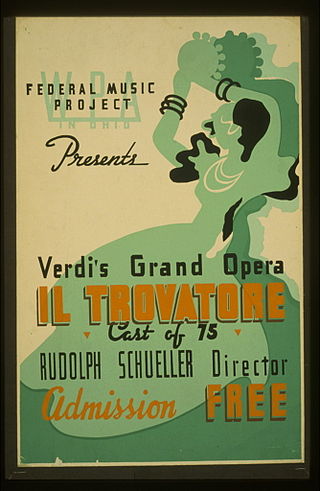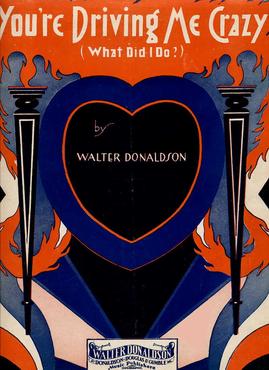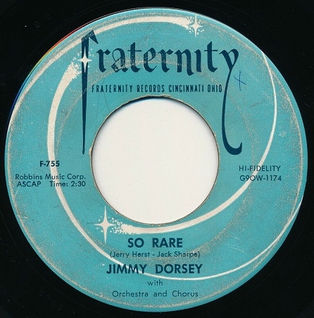Related Research Articles

"Penny Lane" is a song by the English rock band the Beatles that was released in February 1967 as a double A-side single with "Strawberry Fields Forever". It was written primarily by Paul McCartney and credited to the Lennon–McCartney songwriting partnership. The lyrics refer to Penny Lane, a street in Liverpool, and make mention of the sights and characters that McCartney recalled from his upbringing in the city.

This is a list of notable events in music that took place in the year 1937.

Gaetano Alberto "Guy" Lombardo was an Italian-Canadian-American bandleader, violinist, and hydroplane racer.

Dámaso Pérez Prado was a Cuban bandleader, pianist, composer and arranger who popularized the mambo in the 1950s. His big band adaptation of the danzón-mambo proved to be a worldwide success with hits such as "Mambo No. 5", earning him the nickname "King of the Mambo". In 1955, Prado and his orchestra topped the charts in the US and UK with a mambo cover of Louiguy's "Cherry Pink ". He frequently made brief appearances in films, primarily of the rumberas genre, and his music was featured in films such as La Dolce Vita.

Sweet Baby James is the second studio album by American singer-songwriter James Taylor, released on February 1, 1970, by Warner Bros. Records.

Carmen Lombardo was lead saxophonist and featured vocalist for his brother Guy Lombardo's orchestra. He was also a successful composer. In 1927, Carmen Lombardo was the vocalist of the hit record Charmaine, performed by Guy Lombardo and His Royal Canadians.

Jens Martin Lekman is a Swedish musician. His music is guitar-based pop with heavy use of samples and strings, with lyrics that are often witty, romantic, and melancholic. His work is heavily influenced by Jonathan Richman and Belle & Sebastian, and he has been likened to Stephin Merritt, David Byrne, and Scott Walker.

Wild Cherry was an American funk rock band formed in Mingo Junction, Ohio, in 1970 that was best known for its song "Play That Funky Music".

Albert Edward "Eddie" Calvert was an English trumpeter, who enjoyed his greatest success in the 1950s. Between 1953 and 1958, Calvert achieved seven instrumental hits on the UK Singles Chart, including two chart-toppers": "Oh, Mein Papa" in 1953 and "Cherry Pink " in 1955.

"What I Like About You" is a song by American rock band the Romantics. Written by band members Wally Palmar, Mike Skill and Jimmy Marinos in 1979, the song is included on the band's self-titled debut album (1980), and was also released as a single in late 1979. Marinos, the band's drummer, is the lead vocalist on the song. The band filmed a music video for the song that appeared frequently on MTV during the early 1980s.
"Cherry Pink and Apple Blossom White" or "Cerezo Rosa" or "Ciliegi Rosa" or "Gummy Mambo", is the English version of "Cerisiers Roses et Pommiers Blancs", a popular song with music by Louiguy written in 1950. French lyrics to the song by Jacques Larue and English lyrics by Mack David both exist, and recordings of both have been quite popular. However, Pérez Prado's recording of the song as an instrumental with his orchestra featuring trumpeter Billy Regis, whose trumpet sound would slide down and up before the melody would resume, was the most popular version. Pérez Prado's rendition was first recorded and released in Mexico in 1953 under the full title "Cerezo Rosa ", becoming one of the biggest hits of that year in Mexico. It was then released in the United States in 1954, becoming a hit there in 1955 as it reached number one for 10 weeks on the Billboard chart. It became a gold record, and it was featured on the movie Underwater! (1955), where Jane Russell can be seen dancing to the song. Prado recorded Cherry Pink several times, the best known version being the original hit recording from 1953 and the 1960 recording in stereo. Billboard ranked the former version as the No. 1 song of 1955. The most popular vocal version in the U.S. was by Alan Dale, reaching No. 14 on the chart in 1955.
"Red Sails in the Sunset" is a popular song. Published in 1935, its music was written by Hugh Williams with lyrics by prolific songwriter Jimmy Kennedy. The song was inspired by the "red sails" of Kitty of Coleraine, a yacht Kennedy often saw off the northern coast of Northern Ireland and by his adopted town Portstewart, a seaside resort in County Londonderry.

Peter, Paul and Mommy, released on Warner Bros. in 1969, is the trio Peter, Paul and Mary's first children's album. It contains hits like "Puff the Magic Dragon", among others. The album reached No. 12 on Billboard's Top LPs chart. The single "Day is Done" reached number 7 on the Easy Listening chart and number 21 on the Pop Singles chart.

Move is the debut album by British rock group the Move, released in April 1968 through Regal Zonophone Records. The album features ten Roy Wood compositions, along with three covers which had been a prominent part of the group's live act. Although scheduled for an earlier release, the album was delayed by the theft of the master tapes, which led to the tracks needing to be re-recorded. The album was sporadically recorded between January 1967 and February 1968 at Advision, De Lane Lea and Olympic Studios in London, during gaps in their tight recording schedule when the group were not booked for any performances.
"Seems Like Old Times" is a popular song, with music and lyrics by Carmen Lombardo and John Jacob Loeb.
Joseph Aloysius Burke was an American composer, pianist and actor. His successful songs, written with various lyricists, included "Down Honolulu Way" (1916), "Oh How I Miss You Tonight" (1924), "Tiptoe Through the Tulips" (1929), "Moon Over Miami" (1935), "Getting Some Fun Out of Life" (1937) and "Rambling Rose" (1948).
"September in the Rain" is a popular song about nostalgia by Harry Warren and Al Dubin, published in 1937. The song was introduced by James Melton in the film Melody for Two. It has become a standard, having been recorded by many artists since.

"You’re Driving Me Crazy" is an American popular song composed by Walter Donaldson in 1930 and recorded the same year by Lee Morse, Rudy Vallée & His Connecticut Yankees and Guy Lombardo & His Royal Canadians.

"So Rare" is a popular song published in 1937 by composer Jerry Herst and lyricist Jack Sharpe. It became a hit for Jimmy Dorsey in 1957.
"Cherry Blossom Clinic" is a song by British rock band The Move, written by their lead guitarist, vocalist, and primary songwriter Roy Wood, intended as the follow up single to their hit "Flowers in the Rain", which reached number two in the Record Retailer chart. Like many of Wood's other songs, "Cherry Blossom Clinic" deals with clinical insanity and loneliness, and makes several pop culture references throughout, which he largely credits to an ambition for writing a children's book. The track was initially recorded in August 1967 at Advision Studios, but was abandoned for three months before being re-recorded in November of that year, and lacks a production credit.
References
- ↑ "It Looks Like Rain in Cherry Blossom Lane", SecondhandSongs.com. Retrieved 11 April 2017
- ↑ Whitburn, Joel (1986). Pop Memories 1890-1954: The History of American Popular Music . Menomonee Falls, Wisconsin: Record Research, Inc. pp. 531. ISBN 0-89820-083-0.
- ↑ Don Tyler, Hit Songs, 1900-1955: American Popular Music of the Pre-Rock Era, McFarland, 2007, p.227